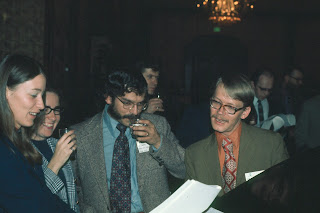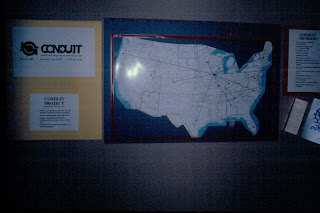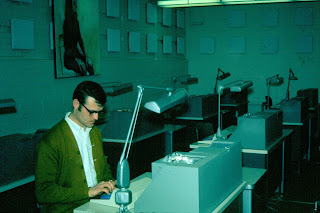I don't recall the reason, if indeed there was one, for this gathering of UCC staff at the west overlook at the Coralville Reservoir. The picture is interesting, but it does make me cringe in a way. There are no women pictured! Women were definitely employed at UCC, not least of them Linda as a systems programmer with others in administrative, keypunch, operations, and other positions. However, our nation has struggled for decades with trying to get more women involved in STEM fields, including computer science. The picture speaks volumes, to me at least, regarding the way things were "back then."
Years ago, with some help, I created a key to the names of the individuals in the picture. One name eludes me still. A prize is offered to the first person to send me that missing name.


In about 1968 and, I believe, partially supported by a grant from the National Science Foundation, the UCC formed a Regional Computer Center (RCC) or Regional Computer Network (RCN). Eleven colleges in Iowa and Illinois were members and were supported, initially only for academic computing, via telecommunications links to their campus equipment, which consisted of "batch computing" systems comprising card readers and line printers. Original members, to the best of my recollection, included: Cornell (Mount Vernon), Coe (Cedar Rapids), Loras and Clarke (Dubuque), Marycrest and Saint Ambrose (Davenport), Luther (Decorah), Central (Pella), Iowa Wesleyan (Mount Pleasant), Augustana (Rock Island), and Grinnell (Grinnell). Later, additional colleges and at least one high school (Mason City) joined. In 1970, as part of continuing to justify the expense of the connections, these members chose to add administrative computing support functions through the work of an RCC staff at UCC/WCC.

Below is a 2770 remote system similar to those used at several RCC schools. Most initially used a 2780, but later the 2770, which incorporated some compression features for faster operation and more efficient use of the telecommunications links, and other devices were used. Learn more
here. This included various small computer systems (DEC PDP 8s and 11s, IBM 1130s and 360/20s) and features that supported the simultaneous ability to send and receive. Eventually, these same capabilities were enhanced so as to allow for a link between Iowa State's and Iowa's computing systems. This link provided for load sharing and access to resources by both campuses (and the RCC as well) available at only one of the two regent universities. These enhancements to the operating systems at each campus were done in collaboration with Triangle University Computer Center (TUCC) in North Carolina.

Another project also initially supported by NSF was CONDUIT, a consortium centered at UCC with members at Cornell, Oregon, North Carolina, Duke, Iowa, and Texas (hence the name of the organization). The purpose of the consortium was to locate and disseminate educational computing resources. As with the RCC, Gerry Weeg was the driving force behind these efforts.
In closing, permit me to mention an interesting book by D.C. Spriestersbach ("Sprie"), whose name will register with those most interested in these current postings on computing at the UI. The book's title is The Way It Was (The University of Iowa 1964-1989). It was published by the University of Iowa Press in 1999. Chapter seven of the book is entitled "The Computer Invasion" and is a fun read for those of us involved during that time.


































